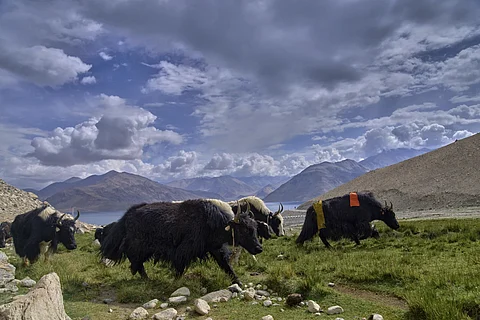

Carrying her one-year-old son on her back, Tsering Dolma herds a dozen yaks into a stone-walled corral as dusk falls over the stark Himalayan landscape of Ladakh.
On the wind-swept plains, where sparse grass fades into gravel and jagged peaks, she is one of the few people visible for miles. For generations, herders like Dolma have depended on snowmelt to feed the high-altitude pastures where their shaggy livestock graze. But now, she says, both snowfall and rainfall have grown increasingly erratic—and so has the grass.
“Earlier, it used to snow and rain, but now it has reduced a lot,” says the 32-year-old. “Even the winters are getting warmer than before.”
In nearby Maan village, Tanzin Dolma milks a yak at dawn as her husband collects yak dung—both part of the daily rhythm of life in this region near Tibet that once formed part of the Silk Route. Much of the herding, milking, and wool-gathering is done by hand, mostly by women.
Further down the valley, 73-year-old Kunzias Dolma brews tea with yak milk and checks her butter as she spins a Buddhist prayer wheel. She has spent her life among yaks, working tirelessly to turn their milk into butter and wool into blankets.
“We wake up at 5 a.m. every day,” she says. “My husband and I milk the yaks and do all the other yak-related work until lunch. Then we rest, and start again in the evening.” But this way of life is rapidly disappearing.
Rising temperatures and unpredictable rains have made survival harder for yaks—cold-loving animals closely related to bison and cattle. Scientists estimate that Ladakh’s average temperature has risen by 3°C (5.4°F) over the past four decades. Heatwaves are now more extreme, and rainfall patterns more erratic.
The impact is visible. Government figures show Ladakh’s yak population declined from nearly 34,000 in 2012 to fewer than 20,000 by 2019. Though yaks still number in the millions globally, scientists say Ladakh’s delicate alpine ecosystem is particularly vulnerable to climate change.
“Earlier, there were a lot of yaks, but now there aren’t as many,” says herder Kunzang Angmo. “There’s less snowfall and less grass.”
Her husband, Tsering Angchok, whose family has raised yaks for generations, agrees: “We get everything from the yak—milk, butter, meat, wool, dung. Nothing goes to waste. Our ancestors lived on this.”
But as rainfall dwindles and vegetation shifts, nourishing grasslands are giving way to invasive weeds. Grazing grounds are shrinking.
“When I was younger, there was more grass, more water and more wildlife,” recalls 70-year-old Thering Norphel. “Now the mountains are bare rock. There’s no snow, no ice, and less water—which means less grass.”
Climate scientists warn the broader Himalayan ecosystem is at risk. Fast-melting glaciers, erratic rains, and retreating snowlines are placing herders—and their animals—under growing stress.
“Both herders and livestock are directly affected,” says Tashi Dorji, a livestock and rangeland expert at the International Centre for Integrated Mountain Development.
Stanzin Rabgais, a government livestock officer, links the rise in bacterial diseases among yaks to increased heat stress.
Experts fear that the decline in herding will have knock-on effects for Ladakh’s ecology. Pastoralists help manage rangelands, control invasive plants, and maintain biodiversity. The sparsely populated region—much of it above 3,000 metres (9,842 feet)—is also home to wildlife including the snow leopard, red fox, and blue sheep.
“If herders disappear, the landscape changes,” Dorji says. “Unpalatable shrubs take over, wildlife loses food sources, and the ecosystem starts to collapse. This is about more than yaks—it’s about the land and a way of life.”
Rabgais believes that yak products could offer economic hope if properly marketed. Yak calf wool, for instance, is finer than most commercial fibres and rivals cashmere in softness.
Despite the challenges, many younger Ladakhis are choosing different paths. Jobs in tourism and the Indian Army, along with access to education, are drawing them away from herding. “The next generation doesn’t want to do this work,” says Norphel. “They’re looking for better pay and easier jobs.”
Abandoned stone shelters dot the landscape—silent testimony to families who have given up yak herding. Still, a few younger herders remain. Among them is 32-year-old Punchuk Namdol, who continues the tradition while others his age seek new opportunities.
“Earlier, we didn’t have any other work—we only had yaks and cattle,” Namdol says. “But now, there’s no one left to take care of them. Yak herding is hard, and fewer people are willing to do it.”
As global warming transforms Ladakh’s fragile environment, the people who have long shaped it—like Dolma, Angchok, and Namdol—must adapt or disappear. Their resilience is evident, but so is the urgency of change.